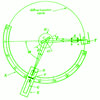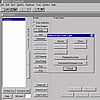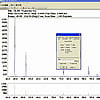Coordinator: ACMAL X-Ray Facility Manager Ed Laitila

Session 1: Design and Set-up of XRD Experiments
In this session the details of XRD experiment design will be discussed with topics such as; understanding what will be determined from the sample, sample preparation, sample mounting, and details of diffraction scan parameters. The diffraction parameters of interest are the scan range, the step size to digitize the data, the count time, and effects of optics.
Design and Set-up of XRD Experiments
Materials added March 4, 2009

Session 2: Detailed Analysis of the XRD Scan Set-up Procedure for the Scintag Θ/Θ Diffractometer
In this session the actual setup of the diffraction instrument and data collection strategies will be discussed along with laboratory procedures, organization of the laboratory, data storage, and procedure to sign up for instrument time. Additionally, a user manual for the instrument will be provided.
XRD Facilities Organization and Important Procedures
Operation Manual for the Scintag θ/θ Diffractometer and DMS-NT Software
Materials updated May 17, 2012

Session 3: Computer Algorithms Used for XRD Data Smoothing, Background Correction, and Creating Peak Files
This session details the features typically determined from diffraction data. This includes how to prepare the data for analysis of peak features by various background models used to subtract the background from the spectrum and methods of smoothing diffraction data. Additionally, the details of typical peak finder programs are discussed as an initial analytical method to determine peak information. Use of these features in the DMSNT software are discussed.
Computer Algorithms Used for XRD Data Smoothing, Background Corrections, and Generating Peak Files
Materials added March 6, 2009

Session 4: Profile Fitting and Graphical Manipulation of XRD Data
Details of profile fitting or matching diffraction data to generally used mathematical profiles. Use of the software and mathematical details of each function are provided. Discussion of peak parameters determined from the profile fitting and meaning of various types of data generated. Use of this feature in the DMSNT software is discussed.
Mathematical Profile Fitting of XRD Data
Mathematical Profile Fitting of XRD Data – DMSNT Operation
Materials added March 6, 2009